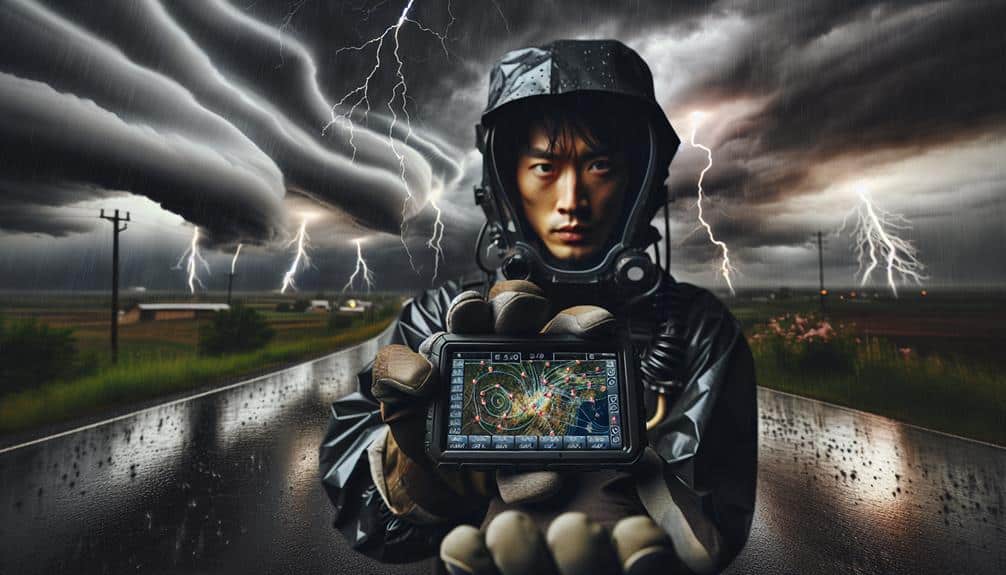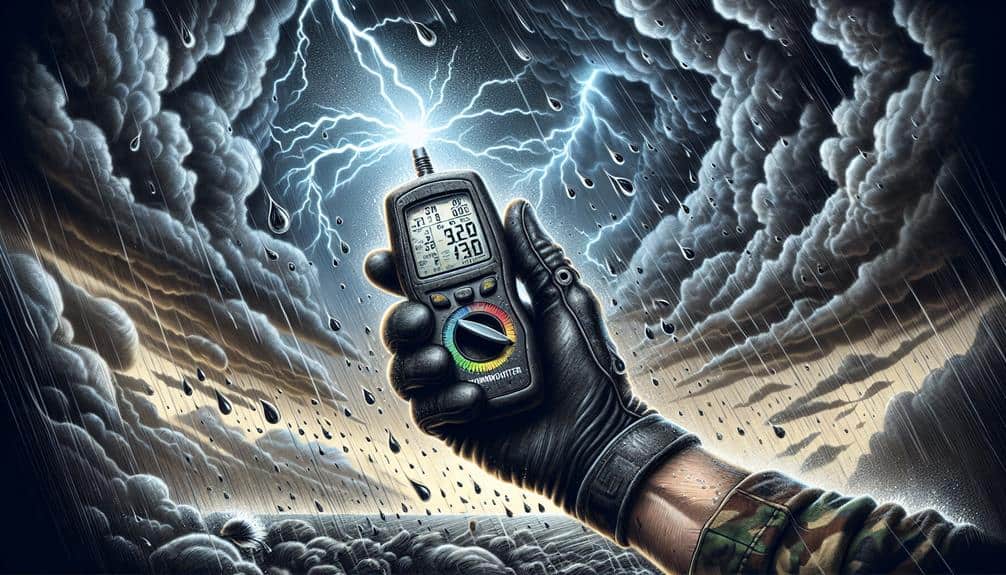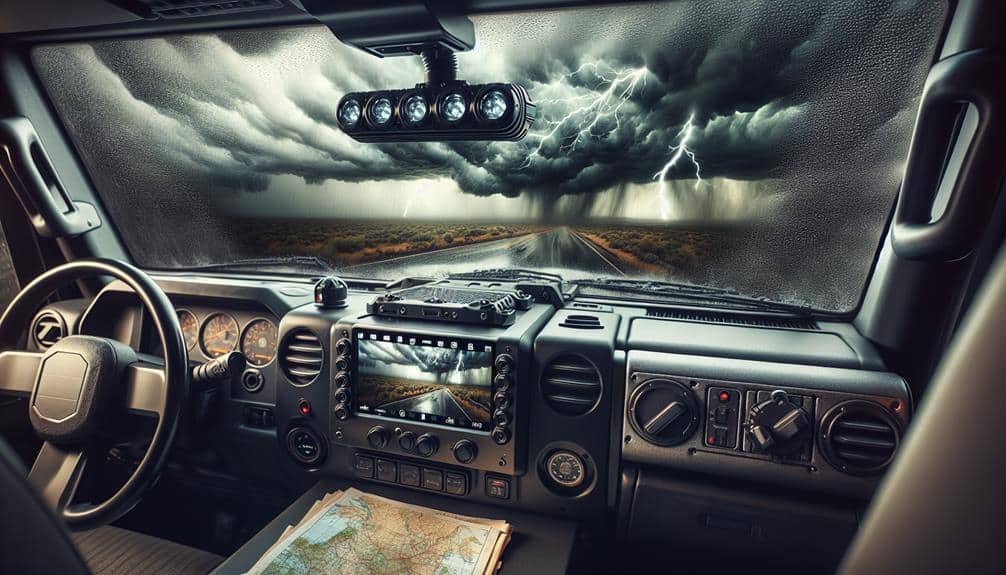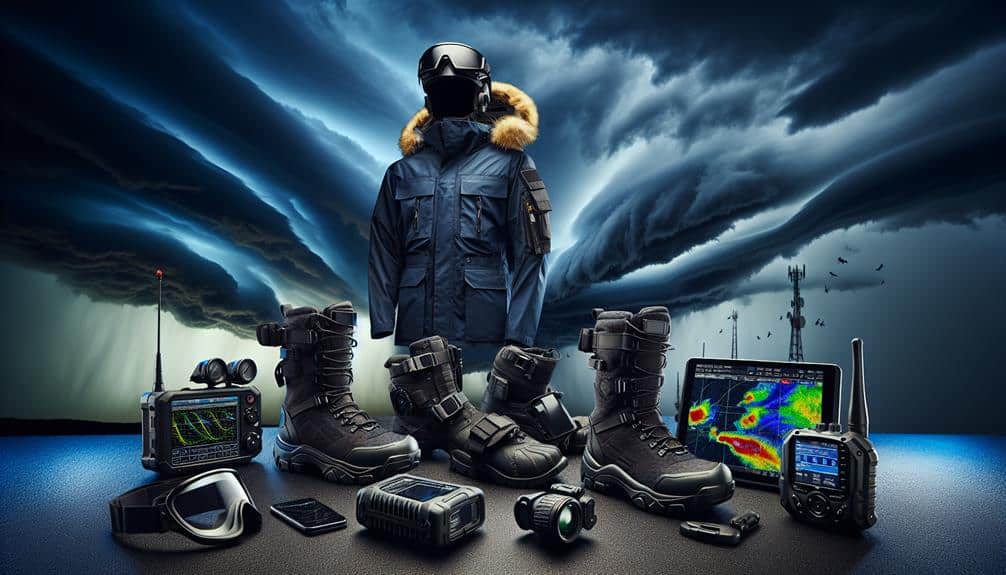We've identified the top 10 communication devices essential for storm chasers. Satellite phones guarantee connectivity in remote areas, while two-way radios offer robust real-time communication. Weather radios provide important updates from the National Weather Service. Mobile hotspots ensure internet access for real-time data. GPS devices are necessary for precise tracking. Handheld anemometers measure wind speeds, and storm tracking apps offer detailed data. Dash cameras capture important footage, and power banks keep devices charged. These tools collectively enhance safety and effectiveness in unpredictable situations. For those keen to explore each device's specifics, the details are up next.
Key Points
- Satellite phones ensure reliable communication and emergency connectivity in remote storm-chasing areas.
- Two-way radios offer robust, real-time communication and coordination with strong signal strength in harsh weather conditions.
- Weather radios provide real-time alerts and updates from the National Weather Service, enhancing safety during severe weather.
- Mobile hotspots guarantee internet connectivity for accessing real-time weather data in remote locations.
Satellite Phones
When chasing storms in remote areas, satellite phones are our lifeline for reliable communication. In the vast expanses where cellular networks falter, satellite phones bridge the gap, ensuring we're never out of touch. They're indispensable for emergency communication, allowing us to summon help swiftly if we encounter life-threatening situations. These devices connect directly to satellites orbiting Earth, offering coverage even in the most isolated locations.
For remote communication, satellite phones provide a reliable means to relay critical weather data back to our teams and meteorologists. This real-time information sharing can be the difference between success and disaster. Weather can turn in an instant; having a dependable line of communication keeps us ahead of the storm.
The durability of these phones is another key advantage. Built to withstand harsh conditions, they remain operational in the face of wind, rain, and debris. Moreover, satellite phones offer essential features like GPS tracking and SOS alerts. These capabilities enable us to keep our exact location known and signal for immediate assistance.
In the end, satellite phones empower us to pursue our passion for storm chasing without compromising our safety or effectiveness.
Two-Way Radios
Two-way radios keep us connected with our team members in real-time, guaranteeing seamless coordination during storm chases. These devices excel in providing reliable communication, which is essential when we're out there facing unpredictable weather. The primary advantage of two-way radios is that they offer strong signal strength, even in remote areas where other communication devices might fail. This reliability is crucial when every second counts, and we need to relay essential information swiftly.
In terms of range coverage, modern two-way radios have come a long way. They can cover several miles, allowing us to maintain contact over expansive areas, whether we're tracking a storm from multiple vantage points or coordinating our movements through rugged terrain. This extended range ensures we can operate with greater freedom and confidence, knowing our team is just a call away.
Moreover, two-way radios are designed to be robust and durable, which is perfect for the harsh conditions we often encounter. They're built to withstand rain, wind, and dust, ensuring they won't let's down when we need them most.
Weather Radios
Weather radios are vital for storm chasers, providing real-time updates and alerts directly from the National Weather Service. These devices keep us informed with the latest emergency alerts, ensuring we're always one step ahead of severe weather conditions. They're an integral part of our preparedness toolkit, giving us the edge when every second counts.
By constantly monitoring weather conditions, weather radios enhance our safety on the field. As storm chasers, we thrive on the thrill of the chase, but we understand how quickly things can change. With a weather radio, we receive immediate notifications about tornadoes, flash floods, and other significant weather events. This real-time information allows us to make swift, informed decisions, ensuring we're not just chasing the storm, but doing so safely.
These radios are designed to be reliable under the harshest conditions. Many models are rugged, portable, and battery-operated, making them perfect for the unpredictable nature of storm chasing. By incorporating weather radios into our gear, we can confidently face the elements, understanding we're equipped with the best tools for weather monitoring and safety.
Let's stay prepared and keep our adventures both thrilling and safe.
Mobile Hotspots
Let's discuss mobile hotspots.
They provide us with dependable internet connectivity, essential for accessing real-time weather data and communicating with our team.
With their portability and impressive battery life, mobile hotspots guarantee we stay connected even in remote storm-chasing locations.
Reliable Internet Connectivity
For storm chasers, maintaining reliable internet connectivity through mobile hotspots is necessary for accessing real-time weather data and staying safe in rapidly changing conditions. We need to rely on these devices to provide us with the information that can make the difference between a successful chase and a dangerous situation.
When considering mobile hotspots, we must evaluate data usage limitations and signal reliability. Data caps can be a significant drawback, especially when we need to stream large amounts of information. It's important to select a plan that offers ample data to avoid throttling at critical moments. Signal reliability is another key factor. We often find ourselves in remote areas where network coverage can be spotty. Choosing a provider known for extensive coverage is crucial.
Next, let's talk about pricing options and service plans. While some mobile hotspots come with a hefty upfront cost, others are more budget-friendly with pay-as-you-go plans. Monthly service plans can vary widely, so it's vital to compare options to find the best balance between cost and the amount of data provided. Flexible plans are great for those who chase storms seasonally, allowing us to switch plans based on our needs.
Portability and Battery Life
When selecting mobile hotspots, portability and battery life are key considerations for storm chasers constantly on the move. We need devices that won't burden us and can last through long hours in the field. A lightweight design paired with reliable charging options guarantees that our gear is as mobile as we are.
Here's what we need to look for:
- Lightweight Design: Every ounce counts when we're carrying around equipment. A compact and lightweight hotspot is essential.
- Long Lasting Batteries: Extended battery life keeps us connected longer, reducing the need for frequent recharges.
- Solar Power: Having a solar charging option can be a game-changer, especially during prolonged chases where traditional power sources are scarce.
- Multiple Charging Options: USB, car adapters, and wall plugs provide flexibility, making sure we're never out of power.
GPS Devices

When we're out in the field, reliable GPS devices are essential for real-time location tracking, ensuring we never lose our way.
These devices boast durable and weatherproof designs, vital for withstanding harsh storm conditions.
Plus, their efficient battery life keeps us going, even during the most extended chases.
Real-time Location Tracking
GPS devices are essential tools for storm chasers, enabling us to track our precise location in real-time as we navigate through severe weather conditions. The effectiveness of real-time communication and the accuracy of our location data are vital for making informed decisions in dynamic environments. When we're chasing storms, every second counts, and our GPS devices make sure we've reliable tracking data to share with our team and emergency responders.
The importance of these devices can't be overstated. Here are key features we look for in a top-tier GPS device:
- Real-time communication effectiveness: Seamless data sharing with our team to coordinate movements and strategies.
- Location accuracy: Pinpoint precision, ensuring we're fully aware of our exact location in relation to the storm.
- Tracking data reliability: Consistent performance, even in remote areas with poor signal coverage.
- Emergency response integration: Direct link to emergency services, enhancing our safety during critical moments.
With these features, we can confidently track our adventures, stay connected, and maintain our safety while experiencing the freedom of storm chasing.
Durable and Weatherproof Designs
Traveling through severe weather demands that our GPS devices not only provide accurate data but also withstand the harsh conditions we encounter. As storm chasers, understanding the importance of durable and weatherproof designs is crucial. Our GPS devices are our lifeline, guiding us through intense rain, high winds, and rugged terrains. This is why waterproof cases and shock resistant devices are non-negotiable features for our gear.
Waterproof cases guarantee that our GPS units continue functioning even in torrential downpours. There's no margin for error when we're moving through a storm, and a water-damaged device could leave us stranded. We opt for devices with high IP ratings, which ensure protection against water and dust ingress.
Shock resistant devices are equally crucial. When we're pursuing a storm, our equipment faces inevitable bumps and drops. A GPS unit that can absorb impacts without compromising its functionality means we can focus on tracking the storm, not worrying about our tools failing us.
In our pursuit of freedom and adventure, we rely on these rugged designs to keep us on course, regardless of the challenges Mother Nature throws our way. They empower us to chase the storm with confidence and precision.
Battery Life Efficiency
Maximizing battery life in our GPS devices is essential for guaranteeing we stay connected and informed during long storm-chasing expeditions. We need to make the most of every charge, making sure our devices are ready when we need them most. Efficient battery management is vital, and there are several strategies we can employ to extend battery life.
- Solar chargers: These provide a sustainable and eco-friendly way to keep our devices powered up. When the sun is out, we can harness its energy, ensuring continuous operation.
- Power-saving modes: Many GPS devices come with settings that minimize energy consumption. Activating these modes can prolong battery life significantly.
- Backup batteries: Carrying extra batteries ensures we've a reliable power source. This is crucial for longevity during multi-day chases.
- Regular charging cycles: Keeping our batteries healthy by not letting them drain completely before recharging can enhance their lifespan.
Emergency Beacons
Emergency beacons are essential tools that guarantee storm chasers can call for help when traditional communication lines fail. When we're out in the field, conditions can change rapidly, cutting off access to standard communication methods.
That's where emergency beacons come into play. These devices send emergency notifications and distress signals, making sure that our location and need for assistance reach rescuers even in the most isolated areas.
Using SOS beacons equipped with satellite communication, we can transmit a call for help with pinpoint accuracy. Unlike cell phones, which rely on terrestrial towers, these devices connect directly to satellites orbiting the Earth. This ensures that even if we're miles away from the nearest cell tower, our SOS signal gets through.
Emergency beacons are designed to be sturdy, weather-resistant, and easy to activate. Many come with features like automated distress signals, which send updates at regular intervals, providing rescuers with our real-time location.
As storm chasers, our mission is to explore and document extreme weather, but safety should never be compromised. With the right emergency beacon, we can chase storms with the confidence that help is just a signal away.
Handheld Anemometers

When it comes to handheld anemometers, we need to focus on wind speed measurement accuracy, portability, and durability.
Accurate readings are essential for predicting storm behavior, while a compact and rugged design guarantees we can use them in the harshest conditions.
Let's explore how these devices enhance our storm-chasing capabilities.
Wind Speed Measurement Accuracy
To guarantee we gather accurate wind speed data during a storm, handheld anemometers must be both precise and reliable under extreme conditions. By ensuring our devices are up to the task, we can confidently analyze storm severity and make critical decisions.
Let's consider the key features that make an anemometer indispensable for storm chasers:
- Precision: High accuracy in wind speed measurement is essential for reliable storm severity analysis.
- Wind direction tracking: Knowing not just the speed but also the direction of the wind enhances our data's completeness.
- Data transmission speeds: Rapid data transfer is vital for real-time communication and timely updates.
- Communication network reliability: Our devices must consistently transmit data, even in areas with poor connectivity.
Our ability to gauge storm dynamics hinges on these features. By focusing on precision instruments, we ensure that data integrity isn't compromised, and our communication remains effective. Fast and reliable data transmission supports our on-the-ground decision-making and ensures we can navigate storms safely while providing important information to our networks.
Portability and Durability
Recognizing the vital role of portability and durability, we need handheld anemometers that are easy to carry and robust enough to face extreme weather conditions. When we're out in the field, our tools must withstand the harshest elements without weighing us down. That's why choosing anemometers with waterproof enclosures and lightweight antennas is a game-changer.
First, waterproof enclosures guarantee our devices remain functional even in heavy downpours, a common scenario for storm chasers. We can't afford equipment failure when every second counts.
The inclusion of lightweight antennas means we won't be burdened by extra weight, allowing us to move swiftly and efficiently.
Durability is equally important. Anemometers equipped with shock-resistant covers can survive accidental drops and impacts. We're often traversing rough terrains, and our gear needs to be as tough as we are.
Compact chargers also play a crucial role. They allow us to power our devices on the go without carrying bulky equipment. The ability to recharge quickly and efficiently means we can stay focused on the storm, not our battery life.
Storm Tracking Apps
Storm tracking apps are essential tools for storm chasers, providing real-time data and advanced mapping features. With these apps, we can stay ahead of the storm, navigate safely, and share critical information with storm chaser communities. The latest developments in storm tracking technology have transformed how we conduct our research, offering more precise and timely data than ever before.
By leveraging storm tracking apps, we gain access to:
- Real-time radar: Visualize storm activity with precision.
- Severe weather alerts: Receive instant notifications about tornadoes, hail, and other severe weather phenomena.
- GPS integration: Track our location relative to the storm, ensuring we stay in safe zones.
- Historical data: Analyze past storm patterns for better predictive capabilities.
These apps have a significant impact on our research efforts. They not only improve our ability to predict and respond to storm behavior but also facilitate collaboration within the storm chaser communities.
The exchange of real-time data and experiences enriches our collective knowledge and enhances our preparedness for future storms. With storm tracking apps, we're not just chasing storms; we're advancing the science of meteorology.
Dash Cameras

While storm tracking apps keep us informed, dash cameras serve as our eyes on the ground, capturing invaluable footage of storm events as they unfold. These devices don't just record mesmerizing visuals; they provide essential video evidence that can be pivotal for both safety and scientific analysis.
When we're out in the field, every second counts. Dash cameras offer real-time documentation of severe weather conditions, giving us a reliable record to analyze later. This footage isn't just for our personal archives; it can assist meteorologists and researchers in understanding storm behavior, thereby contributing to better forecasting and protection strategies.
Dash cameras also enhance our safety. They allow us to document our exact location and the conditions we encounter, which can be critical in emergency situations. In case of an unexpected event, this video evidence can help first responders locate us more efficiently.
Moreover, footage analysis from our dash cameras can reveal patterns that aren't immediately obvious during the chaos of a storm. This data contributes to improving our storm-chasing tactics and ensuring we can continue to pursue our passion safely.
Power Banks
Power banks are indispensable for making certain our devices stay charged during long hours of storm chasing. When we're out in the field, we need to rely on reliable power sources to keep our communication devices, GPS units, and cameras operational. The right power bank can make all the difference.
To make an informed choice, we should focus on the following key features:
- Battery capacity: Opt for power banks with high mAh ratings to secure multiple charges for our devices.
- Charging efficiency: Seek units that minimize energy loss during transfer to get the most out of each charge.
- Compatibility with devices: Ensure the power bank can charge all of our essential equipment, from smartphones to radios.
- Fast charging technology: Prioritize power banks that support quick charging to minimize downtime.
We can't afford to have our devices run out of juice at critical moments. By investing in high-capacity, efficient, and fast-charging power banks, we're guaranteeing our gear stays powered up, allowing us to stay connected and focused on capturing the storm. This level of preparedness grants us the freedom to chase safely and effectively.
Frequently Asked Questions
What Are the Best Protective Cases for Communication Devices?
We need durable, waterproof cases and shockproof options for our communication devices. Impact-resistant cases provide extra protection against drops and harsh conditions. Let's choose the best to guarantee our gear stays safe and functional.
How Do You Maintain Battery Life During Long Storm Chasing Sessions?
We keep our batteries alive like the storm's fury with solar charging and power management. Portable generators and car chargers are our lifelines, ensuring we never lose power during those electrifying chases.
Are There Any Communication Devices Specifically Designed for Extreme Weather Conditions?
We rely on waterproof walkie talkies and satellite phones for emergencies. These devices guarantee we stay connected in extreme weather conditions. They're essential for our safety and freedom to chase storms without worrying about communication breakdowns.
What Backup Power Options Are Recommended if Power Banks Fail?
If power banks falter, we suggest solar chargers or generators. Additionally, car chargers and portable panels offer dependable backup options. These tools guarantee we stay connected, providing us the freedom to concentrate on the storm's trajectory.
Can Communication Devices Interfere With Weather Data Collection Instruments?
We should be cautious because communication devices can cause interference, potentially impacting the data accuracy of weather data collection instruments. Ensuring our devices are properly shielded helps maintain the integrity of collected weather data.


